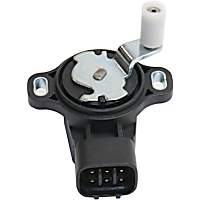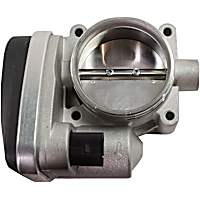Your vehicle’s throttle position (TP) sensors and accelerator pedal position (APP) sensors are crucial to engine operation. Just like any other engine sensor, these sensors may fail due to several reasons. P0120 is an error code that indicates a potential fault with one of your vehicle’s TP/APP sensors or the sensor’s circuit.
What does the P0120 Code Mean?
Diagnostic trouble code (DTC) P0120 stands for “Throttle/Pedal Position Sensor ‘A’ Circuit.” It is triggered once the powertrain control module (PCM) detects abnormal voltage readings from one of your car’s TP or APP sensors. To understand the code better, let us briefly discuss how TP and APP sensors operate.
Note: The definition of Code P0120 may vary depending on the vehicle manufacturer. It is best to consult a repair manual or repair database for the exact code definition.
TP Sensors

A TP sensor measures your throttle blade opening. The number of TP sensors may vary depending on your vehicle’s make and model. For example, older vehicles that have mechanical throttle linkage are equipped with only one TP sensor. On the other hand, vehicles with electronic throttle control (ETC) are equipped with two sensors. Usually, these sensors are located on the throttle body assembly.
The data from your TP sensors is sent to your PCM, which uses the information when adjusting idle speed, fuel delivery, and shift points. On vehicles with ETC, the data is also used for throttle motor/throttle blade control.
Faults in these sensors are serious, particularly for vehicles with ETC, because they may cause the vehicle to go into fail-safe mode. This is a condition where the car’s speed and acceleration are limited to avoid uncontrolled acceleration.
Our in-depth guide about throttle position sensors could help you come up with a proper DIY fix for P0120.
APP Sensors

On some vehicles, the P0120 code may indicate problems with one of your car’s APP sensors. In an ETC system, APP sensors are used as a primary input for throttle blade/throttle motor control.
Once the PCM detects a deviation from the expected voltage signals from the APP sensor or TP sensor, it will trigger the code.
P0120 on Some Toyota Vehicles
Code P0120 may appear on some Toyota vehicles like the 2001 Toyota Tacoma 2.4L L4. Some of the possible causes of P0120 code in a 2001 Toyota Tacoma can include:
- Open or short in throttle position sensor circuit
- Faulty Throttle position sensor
- ECM issues
After confirming the DTC P0120 in your 2001 Toyota Tacoma, use the OBD II scan tool or TOYOTA hand−held tester to confirm the throttle valve opening percentage and closed throttle position switch condition.
What are the Possible Causes of the P0120 Code?
It may be difficult to pinpoint what underlying problem is causing error code P0120. To give you an idea, here are the possible causes of the P0120 code:
- Faulty throttle position sensor
- Faulty accelerator position sensor
- Damaged or corroded wiring or connectors
- PCM issues, such as software in need of an update
- Dirty or defective throttle body

What are the Common Symptoms of the P0120 Code?
Code P0120 will most likely trigger the “Check Engine Light.” Aside from that, here are some of the symptoms you should watch for:
- Engine may misfire
- Hard Starting (rare cases)
- Engine may hesitate during acceleration (rare cases)
How to Diagnose the P0120 Code
Again, the code P0120 is not an issue you can disregard, especially if your vehicle relies on ECT systems. It is best to bring your vehicle to your trusted repair shop for proper diagnosis.
However, if you have advanced auto repair skills, and you would want to diagnose this trouble code yourself, here is a video that can help you understand the code better:
How to Fix the P0120 Code
One of the main causes of a triggered P0120 code is a faulty TP or APP sensor. It could be faulty wiring leading to the TP sensor.
To check whether your vehicle’s TP sensor is faulty, you’re going to need to check it with a multimeter. The TP sensor is typically mounted on the throttle body and is connected to the throttle body with screws. The sensor also has a plug and connectors protruding from its side. The throttle body of some vehicles will be visible as soon as the hood is opened. However, this might not be readily accessible for some vehicles. You can check your owner’s manual to verify its location.
Once you’ve found the TP sensor, set your multimeter to its 10 DC voltage range and then place the black negative probe on the ground terminal of the TPS. Put the red positive prime on the reference voltage terminal of the TPS. If the multimeter doesn’t read 5 volts, then the TPS is faulty.
To fix the P0120 code, you’ll need to repair or replace the TP sensor. You might also need to repair any damaged wires that you might find.
To replace the TP sensor, simply pull out the sensor’s electrical connector by pushing down a tab on its side. Afterward, remove the TP sensor’s mounting screws using a screwdriver. Once the screws have been removed, you can remove the TP sensor.
To install the replacement TP sensor, simply insert the mounting screws on the sensor while they’re aligned with the screw holes. Then tighten the screws with a screwdriver. Reconnect the sensor’s electrical connector to complete the process.
Diagnosing and fixing issues concerning these parts might involve more steps depending on your problem and specific vehicle model. Check your manual or look for online resources to help you. If you aren’t confident in your DIY skills then this procedure can be a challenge. Don’t hesitate to have a mechanic do this repair for you.
Get the Right Parts to Fix the P0120 Code
A bad throttle position sensor can trigger the P0120 code and cause engine issues such as misfires. This might not be concerning now, but it can damage your engine if you ignore it. The throttle position sensor is important and you shouldn’t let a faulty sensor persist. Here at CarParts.com, you can find a list of replacement throttle position sensors for your specific vehicle with just a few clicks.
CarParts.com has a curated selection of parts to help you get your car back on the road. Choose between a wide range of parts for the engine and A/C system, to name a few. Whatever part you choose, you can be confident it’ll fit properly and perform great. All our parts are sourced from reputable manufacturers and have passed stringent quality control standards.
What are you waiting for? Shop for a new throttle position sensor here at CarParts.com today!
Products Mentioned in this Guide
Any information provided on this Website is for informational purposes only and is not intended to replace consultation with a professional mechanic. The accuracy and timeliness of the information may change from the time of publication.


 Throttle Position Sensor
Throttle Position Sensor
 Accelerator Pedal Position Sensor
Accelerator Pedal Position Sensor
 Throttle Body
Throttle Body
















